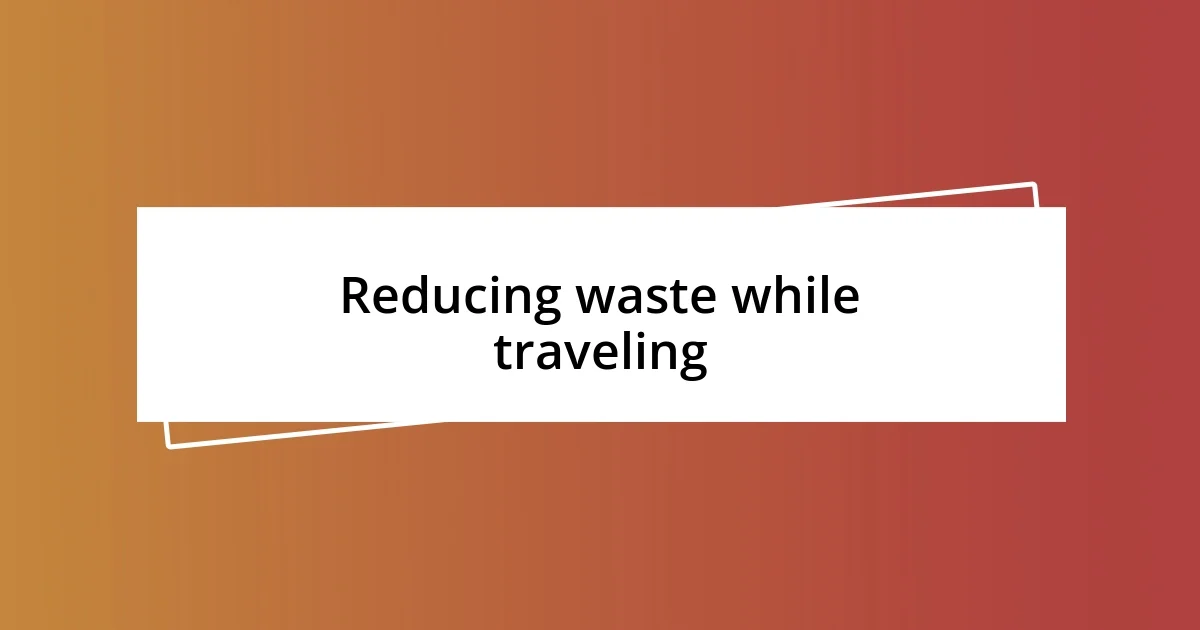Key takeaways:
- Understanding the carbon footprint of travel highlights the impact of individual choices on climate change and vulnerable communities.
- Adopting sustainable travel practices—such as choosing public transport, supporting eco-friendly businesses, and reducing waste—enhances travel experiences while minimizing environmental impact.
- Offsetting carbon emissions through credible programs and participating in local conservation efforts fosters a deeper connection to the destinations visited and promotes responsible travel.

Understanding carbon footprint effects
When I first grasped the concept of a carbon footprint, I was shocked to learn how individual choices, particularly in travel, contribute to climate change. This realization hit home during a family trip when we flew across the country. The enormity of the plane’s emissions lingered in my mind—did we really need to take that flight, or could we have explored our own backyard instead?
As I started to understand the effects of carbon emissions, I couldn’t help but reflect on how they impact not just the environment but communities around the world. I remember reading about vulnerable populations facing extreme weather conditions, largely fueled by our emissions. Isn’t it eye-opening to think about how a single decision to travel can resonate through entire ecosystems, affecting the lives of people we may never meet?
When I decided to minimize my travel carbon footprint, I felt a sense of empowerment. It was liberating to know that even small changes, like choosing a train over a plane or supporting eco-friendly accommodations, can make a difference. Don’t you want to feel that you’re part of the solution? By collectively making these mindful choices, we not only reduce our carbon footprints but also embrace a new way of experiencing the world—one that respects the delicate balance of our planet.

Choosing sustainable travel options
When it comes to choosing sustainable travel options, I’ve found that every decision matters. For instance, opting for train travel over flying not only reduces emissions but also offers breathtaking scenery along the way. I remember my trip to the mountains, where the train ride was just as enjoyable as the destination itself, filled with beautiful views that a plane window could never provide.
I also pay close attention to my accommodations. Supporting eco-friendly hotels that reflect my values has become a priority for me. These places often use renewable energy and implement waste reduction practices, allowing me to enjoy my stay while knowing I’m doing my part for the planet. That feeling of contributing to something bigger during my trips is incredibly fulfilling.
Finally, I look for local transportation options, like biking or public transit, instead of renting a car. During my recent visit to a vibrant city, I hopped on a bicycle and discovered hidden gems I otherwise would have missed. There’s something magical about experiencing a place at a leisurely pace, don’t you think? It’s these sustainable choices that make my travels more enriching and environmentally responsible.
| Travel Option | Environmental Impact |
|---|---|
| Flying | High CO2 emissions per person, significant climate impact |
| Train | Lower CO2 emissions, more scenic views |
| Eco-friendly Hotels | Minimized waste, renewable energy use |
| Biking/Public Transit | Very low emissions, supports local economy |

Packing light for eco-friendliness
Packing light has been a transformative experience for me, not just in terms of convenience but also in making my travels more eco-friendly. The moment I realized that my oversized suitcase could contribute to unnecessary carbon emissions, I decided it was time to rethink how I packed. Each item I leave out not only lightens my load but also reduces the weight that planes and cars carry, leading to less fuel consumption. It’s like traveling with a sense of purpose, knowing that each decision contributes to minimizing my carbon footprint.
Here are some practical strategies I’ve adopted for packing light:
- Choose versatile clothing: I prefer packing clothes that can be mixed and matched, allowing for multiple outfits without needing to carry excess.
- Opt for lightweight gear: Investing in lightweight travel essentials has made a world of difference. They take up less space and often weigh significantly less.
- Limit footwear: I usually stick with two pairs of shoes—ones that are comfortable for walking and a dressier pair. This reduces bulk and helps me stay agile while exploring.
- Utilize packing cubes: These help me organize my items efficiently, maximizing space and making my suitcase feel less chaotic.
- Leave behind non-essentials: I’ve learned to assess which items are genuinely necessary and which are just “in case” items. It’s surprising how freeing it is to let go of that mindset.
Every time I unpack at my destination, I can feel the relief—not just from the weight of my bag, but also knowing that I made choices aligned with my commitment to the environment. It really enhances my travel experience and opens up more room for adventures.

Using public transport effectively
Utilizing public transport effectively has been a game-changer for my travels. I recall this one time in Paris when I decided to forgo any pre-conceived notions about public transport being inconvenient. Instead, I hopped onto the Metro, and it turned out to be one of the easiest and most efficient ways to navigate the city. Not only did I avoid the stress of traffic, but I also mingled with locals, which offered me insights into their daily lives that I would have missed otherwise. Have you ever experienced that sense of belonging when using local transport?
I’ve always believed that timing is key when it comes to public transport. For example, catching the bus during off-peak hours means not only a more relaxed ride but also a cleaner vehicle with less pollution. During a recent trip to London, I strategically planned my museum visits around public transport schedules. This not only saved time but also allowed me to appreciate the journeys themselves, where every stop was a new opportunity to soak in the city’s unique culture. It’s fascinating how being mindful can transform simple rides into memorable experiences.
Another tip I swear by is using apps that provide real-time information on public transit options. I remember feeling anxious about getting lost in a new city, but finding an app that mapped out the quickest routes and station details made all the difference. Whether it’s a bustling bus route in Tokyo or a serene tram in Amsterdam, having that information at my fingertips has empowered me to explore more confidently. Don’t you just love how technology enhances our travel experiences while being kinder to the planet?

Supporting local and eco-friendly businesses
Supporting local and eco-friendly businesses has become a vital part of my travel philosophy. During a recent trip to a small coastal town, I stumbled upon a quirky little café run by a local family. Not only were they serving delicious, organic meals made from ingredients sourced from nearby farms, but the atmosphere was warm and inviting, making me feel right at home. Have you ever noticed how much more fulfilling a meal tastes when you know it supports the community?
On another occasion, I sought out artisanal shops specializing in locally crafted souvenirs instead of the usual mass-produced trinkets. I found myself drawn to a beautiful handwoven rug made by a local artisan. The experience was much more enriching than picking up a generic item at a tourist trap. Each purchase felt like a story, a connection to the culture and craftsmanship of the area. It’s amazing how supporting these businesses not only benefits the economy but also enhances our understanding of the places we visit.
I also prioritize eco-friendly accommodations, such as a charming bed-and-breakfast that implemented sustainable practices. They used solar energy and minimized plastic waste while providing exceptional hospitality. I remember sitting on the porch, sipping freshly brewed coffee, and feeling a profound sense of satisfaction knowing my stay was contributing to a greener planet. Have you ever thought about how your choices as a traveler can ripple out and create a positive impact on communities? Embracing this approach has truly transformed my travel experiences for the better.

Reducing waste while traveling
Reducing waste while traveling has become a cornerstone of my adventures, and it starts with simple choices. On my last trip, I made a conscious effort to bring my reusable shopping bag along for the journey. It felt empowering to decline single-use plastic bags during shopping trips, and honestly, it sparked conversations with shopkeepers about sustainability. Has a small change ever made you feel like a part of something bigger?
Then there’s the challenge of food waste, which I tackled head-on by embracing smaller, local eateries. I remember trying a new dish at a family-run restaurant and finding out they only serve what’s in season. It felt rewarding to know that I was not just enjoying a meal but also supporting a zero-waste philosophy. Have you ever felt connected to a place through its local flavors, knowing that your dining choices are eco-conscious?
Finally, one of my best strategies for reducing waste has been to avoid single-use items, especially during trips. I always pack a reusable water bottle and utensils, which saved me from countless disposable plastics. While trekking through the stunning landscapes of Patagonia, sipping water from my stainless steel bottle felt like a small victory. It’s ironic how little choices can showcase our commitment—have you ever thought about the difference even one person can make? Each of these practices has not only reduced my waste but also enriched my travel experience in ways I never imagined.

Offsetting carbon emissions responsibly
When it comes to offsetting carbon emissions responsibly, choosing credible carbon offset programs is key. I remember researching a specific initiative focused on reforestation in the Amazon rainforest. Supporting it felt like reconnecting with nature and providing real benefits to the planet. Have you ever considered how investing in such projects could transform your travel impact?
Another approach I’ve found meaningful is participating in local conservation efforts during my travels. On a trip to Costa Rica, I volunteered for a beach clean-up and felt a true sense of accomplishment as we collected trash that would otherwise harm marine life. It’s fascinating how direct involvement allows us to see the direct benefits of our efforts—don’t you appreciate that hands-on effort can forge a connection to the places we visit?
I’ve also learned to think critically about the offsets I choose. One time, I opted for a program certified by a recognized environmental standard. It reassured me that my contributions would genuinely fund projects reducing greenhouse gases. How do you choose to ensure your offsets are making a real difference? Knowing I was supporting a transparent and effective initiative elevated my sense of responsibility as a traveler.














